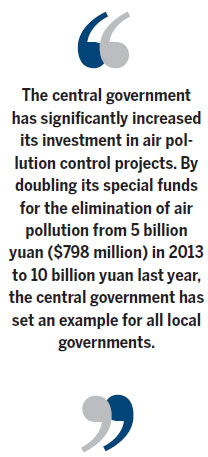A silver lining in fight against smog
Updated: 2015-03-13 08:08
By Zhang Xiaode(China Daily Europe)
|
|||||||||||
Crackdown on polluters in Beijing-Tianjin-Hebei area has been effective in reducing air pollution
Smog is a hot topic at the two sessions with Premier Li Keqiang vowing to enforce environmental regulations in the Government Work Report.
The efforts made by governments at all levels to curb pollution have had a positive effect in the past year, which to many marks the first year that air pollution has been reined in. More importantly, a mechanism for cross-regional cooperation involving both short-term emergency measures and long-term institutional endeavors, is taking shape.
According to statistics released by the Ministry of Environmental Protection, all 74 major Chinese cities subject to air quality monitoring of PM2.5, carbon monoxide and ozone reportedly met the national standards for clear air on 241 days on average last year. For the Beijing-Tianjin-Hebei area, which has been plagued by frequent and severe smog in recent years, the figure was 156 days. The concentration of PM2.5 in the Beijing-Tianjin-Hebei area was reduced from 106 micrograms in 2013 to 93 micrograms over the same period. Such monitoring data indicate that the country's tough pollution fight throughout 2014 began to be effective. However, despite the decrease in PM2.5 concentration, the figure of 93 micrograms was still nearly three times higher than the standard level.

The central government has significantly increased its investment in air pollution control projects. By doubling its special funds for the elimination of air pollution from 5 billion yuan ($798 million) in 2013 to 10 billion yuan last year, the central government has set an example for all local governments.
Acknowledging that the root cause of most cases of air pollution is usually related to industries that generate illegal and excessive emissions, the terribly polluted Beijing-Tianjin-Hebei area, for example, witnessed several noteworthy moves aimed at cracking down on the major pollutant producers in the region.
The following numbers speak louder than any hollow bureaucratic speeches do. The capital, last year alone, weeded out nearly 476,000 vehicles generating illegal exhaust emissions, and closed some 392 polluting enterprises, such as those in the chemical and printing industries. Meanwhile, 268 local enterprises received due punishments and 31 were shut down in neighboring Tianjin, with approximately 90 suspects held accountable for allowing pollution.

Although more than 7,000 enterprises were punished in Hebei province during 2014, many of them, such as steel producers, were seen as local economic pillars. The whole province, as a result, is still struggling to find alternative sources of growth following the closures.
Nevertheless, the truth is, most of these "pillar industries" were already nearing obsolescence because of overstaffing and excess capacity. Of course, local governments should compensate the closed enterprises in accordance with the relevant laws and more importantly, encourage companies to adapt to the new energy economy.
Given the borderless nature of air pollution, the Beijing-Tianjin-Hebei area is in dire need of the coordinated control mechanism that started to take shape last year. Aside from a regional committee for preventing air pollution and an information-sharing system based on air quality, the three areas are also working to reduce emissions of sulfur dioxide and nitrogen oxides by controlling major airborne pollutant generators.
To keep track of the real-time air quality around China, governments at all levels have set up over 1,400 monitoring stations, while the environmental watchdog completed a massive online monitoring system on polluting industries, the biggest of its kind in the world.
Public awareness of smog-related dangers that was absent for a long time, has also been aroused. A free smartphone application "Pollution Map" developed by the Institute of Public and Environmental Affairs, an environmental group in Beijing, allows users to check the latest emissions in about 190 Chinese cities on an hourly basis, and has become a hit with the public. This is indeed a promising trend, despite there still being a long way to go in the country's war against air pollution.
The author is a professor and director of ecological civilization research center at the Chinese Academy of Governance. The views do not necessarily reflect those of China Daily.
(China Daily European Weekly 03/13/2015 page11)
Today's Top News
China likely to ease again if inflation falls: insider
Reproach for wrongful convictions
China's two universities make top 50
Astronauts return from space station
Italian court upholds Berlusconi's acquittal
UK companies seek new opportunities in China
CNR, CSR merger passes overseas antitrust scrutiny
Official urges Dalai Lama to forsake evil ways
Hot Topics
Lunar probe , China growth forecasts, Emission rules get tougher, China seen through 'colored lens', International board,
Editor's Picks

|

|

|

|

|

|





